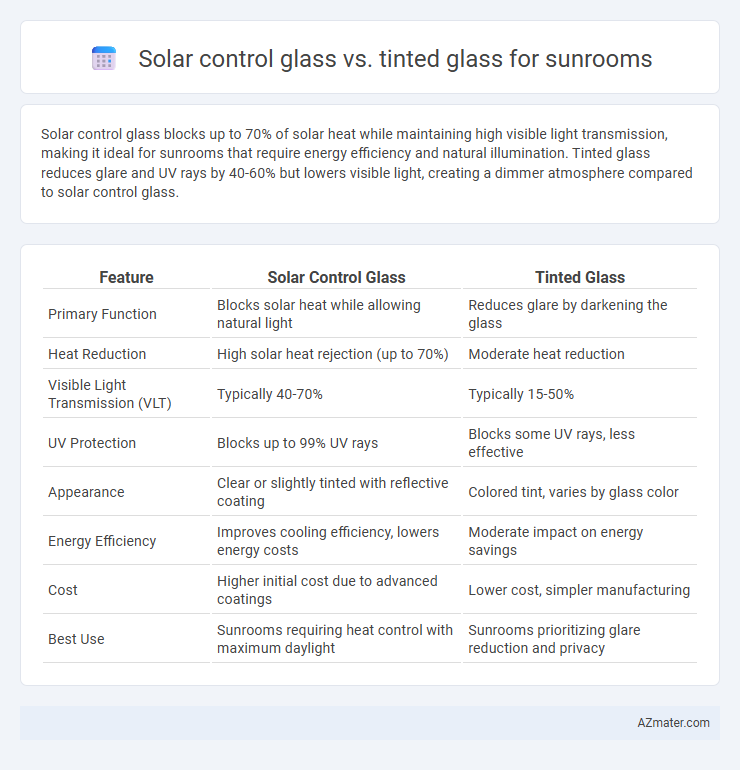Solar control glass blocks up to 70% of solar heat while maintaining high visible light transmission, making it ideal for sunrooms that require energy efficiency and natural illumination. Tinted glass reduces glare and UV rays by 40-60% but lowers visible light, creating a dimmer atmosphere compared to solar control glass.
Table of Comparison
| Feature | Solar Control Glass | Tinted Glass |
|---|---|---|
| Primary Function | Blocks solar heat while allowing natural light | Reduces glare by darkening the glass |
| Heat Reduction | High solar heat rejection (up to 70%) | Moderate heat reduction |
| Visible Light Transmission (VLT) | Typically 40-70% | Typically 15-50% |
| UV Protection | Blocks up to 99% UV rays | Blocks some UV rays, less effective |
| Appearance | Clear or slightly tinted with reflective coating | Colored tint, varies by glass color |
| Energy Efficiency | Improves cooling efficiency, lowers energy costs | Moderate impact on energy savings |
| Cost | Higher initial cost due to advanced coatings | Lower cost, simpler manufacturing |
| Best Use | Sunrooms requiring heat control with maximum daylight | Sunrooms prioritizing glare reduction and privacy |
Introduction to Sunroom Glazing Options
Sunroom glazing options primarily include solar control glass and tinted glass, each designed to manage solar heat gain and light transmission differently. Solar control glass utilizes special coatings to reflect infrared and UV radiation, reducing heat buildup while maintaining clear visibility and natural light. Tinted glass, by incorporating color pigments, absorbs and decreases sunlight, offering enhanced glare reduction but often resulting in darker interiors and altered external appearance.
What is Solar Control Glass?
Solar control glass is designed to reduce heat gain by reflecting and absorbing solar radiation while maintaining visible light transmission, making it ideal for sunrooms seeking energy efficiency and comfort. Unlike tinted glass, which darkens the appearance and can reduce natural light, solar control glass balances glare reduction with clarity and UV protection. This specialized glazing helps lower cooling costs and prevents furniture fading without compromising the aesthetic transparency of the sunroom.
Understanding Tinted Glass for Sunrooms
Tinted glass for sunrooms reduces heat gain by absorbing solar radiation, lowering indoor temperatures and enhancing comfort. This type of glass often comes in various shades, offering privacy while maintaining natural light transmission. Compared to solar control glass, tinted glass primarily focuses on heat absorption rather than reflective coatings, affecting the sunroom's overall energy efficiency and aesthetics.
Key Differences Between Solar Control and Tinted Glass
Solar control glass significantly reduces solar heat gain by reflecting and absorbing infrared rays, improving energy efficiency in sunrooms, while tinted glass primarily darkens the glass to block visible light without substantially reducing heat. Solar control glass often has a special coating that maintains clarity and natural daylight transmission, unlike tinted glass which can reduce natural light and alter color perception. Choosing solar control glass enhances comfort by minimizing glare and heat buildup, whereas tinted glass may only provide aesthetic shading without effective thermal performance.
Energy Efficiency Comparison
Solar control glass significantly reduces solar heat gain by selectively filtering infrared rays while maintaining high visible light transmission, enhancing energy efficiency in sunrooms by lowering cooling costs. Tinted glass absorbs and blocks sunlight to reduce glare and heat but can also decrease natural daylight, potentially increasing reliance on artificial lighting and raising energy consumption. Choosing solar control glass optimizes thermal regulation and daylighting balance, making it a superior energy-efficient option for sunroom applications.
Light Transmission and Interior Comfort
Solar control glass typically reduces visible light transmission by 40-60%, significantly minimizing glare and heat gain, making sunrooms more comfortable during peak sunlight hours. Tinted glass allows 30-70% light transmission but often compromises natural light quality, potentially creating a darker interior atmosphere. Choosing solar control glass optimizes interior comfort by balancing ample daylight with effective solar heat rejection, enhancing energy efficiency and occupant well-being.
Impact on UV Protection and Fading
Solar control glass offers superior UV protection for sunrooms by effectively blocking up to 99% of harmful ultraviolet rays, significantly reducing furniture and flooring fading compared to tinted glass. Tinted glass primarily reduces glare and solar heat gain but allows more UV transmission, resulting in greater long-term damage to interior materials. Selecting solar control glass enhances sunroom longevity by minimizing UV-induced fading and preserving interior aesthetics.
Aesthetics and Visual Appeal
Solar control glass enhances sunroom aesthetics by offering a sleek, neutral tint that reduces glare and heat without distorting natural colors, maintaining a bright and inviting atmosphere. Tinted glass provides a range of color options that can create unique visual effects but may darken interiors and alter the true color perception of the surroundings. Choosing solar control glass ensures a balanced mix of comfort and style, preserving the sunroom's clarity and modern appeal while managing solar heat gain effectively.
Cost Considerations and Long-Term Value
Solar control glass for sunrooms typically involves higher initial costs due to advanced coatings that reduce heat gain and UV penetration, enhancing energy efficiency and comfort. Tinted glass offers a more affordable upfront option but may compromise natural light quality and does not provide as effective thermal regulation. Over time, solar control glass delivers better long-term value through lower cooling costs and increased durability, making it a cost-effective investment despite the higher initial price.
Choosing the Best Glass Type for Your Sunroom
Solar control glass is designed to reflect and absorb a significant amount of solar heat, reducing indoor temperature and UV exposure, making it ideal for sunrooms in hot climates. Tinted glass offers a darker appearance and blocks glare but often lets more heat pass through compared to solar control glass. Choosing the best glass type depends on balancing heat reduction, natural light entry, and aesthetic preferences to create a comfortable and energy-efficient sunroom.

Infographic: Solar control glass vs Tinted glass for Sunroom
 azmater.com
azmater.com